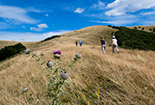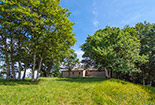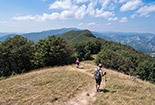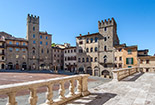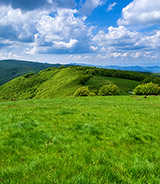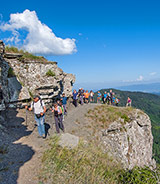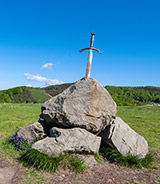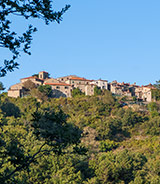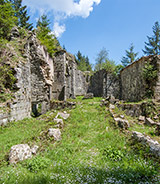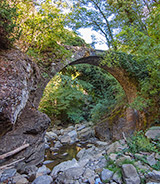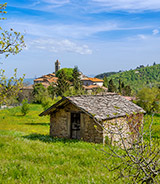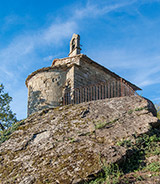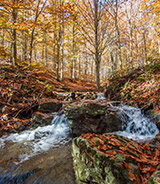Walking with the Monk Guido
walks and trekking in places of high historical value where Guido d'Arezzo walked
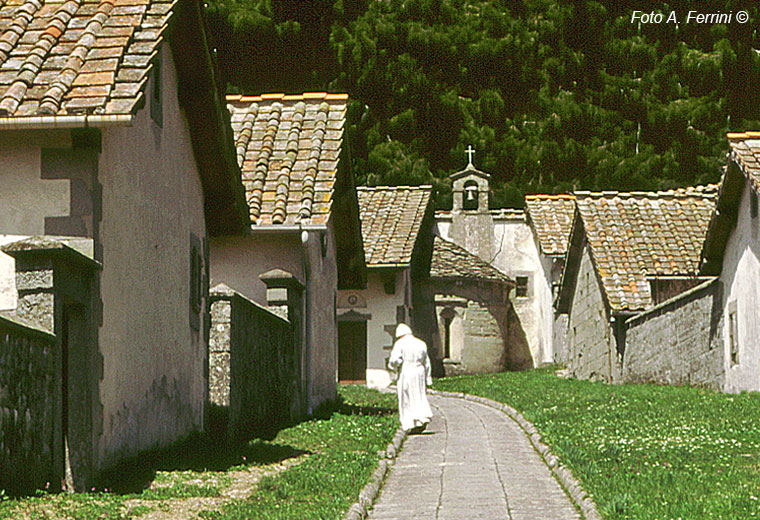
Texts and photos by Alessandro Ferrini ©
Arezzo, a city of art with lots of history and nature in the surrounding area
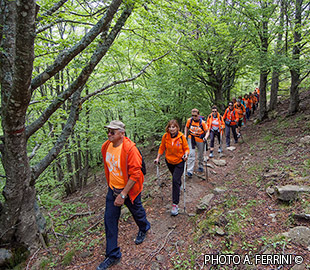 Arezzo is a city that can satisfy tourists passionate about ancient history, art, with Piero della Francesca and Vasari representing its flagship, and architecture which shows its maximum expression with Romanesque and Gothic style churches . Furthermore, due to its geographical position, the land of Arezzo can satisfy the needs of those who also want to enjoy the Tuscan landscapes and beautiful nature. This is possible through relaxing walks or more challenging trekking routes.
Between 1025 and 1030, Bishop Teodaldo hosted a great scholar from the Abbey of Pomposa in the city: Guido Monaco. A character who in the following centuries would acquire worldwide fame for having been the inventor of the musical notation still used today. A method that he organized during the years of his stay in Arezzo, perhaps better to say in Arezzo. In fact, it is very likely that Guido Monaco did not only reside in the city, but moved to meet his Benedictine brothers who were in monasteries and abbeys in the Arezzo area, first of all Santa Trinita in Alpe, on the southern slopes of Pratomagno, in the Municipality of Talla. This, founded around 960, in the years in which Guido Monaco was in Arezzo, was a reference for Benedictine culture. In the decades following the foundation of Santa Trinita, other abbeys and monasteries arose in the area between Pratomagno and Arezzo. Religious places connected to each other by a dense road network to which Guido Monaco will certainly have visited.
It is along this network of ancient roads that the itineraries indicated on this page wind their way. Paths for walking, trekking and mountain biking. Walking along these itineraries we will find ourselves immersed in nature, but also inside history. We will be accompanied by woods and amazing views, but we will also encounter architectural structures and works of art of absolute importance. Furthermore, it is not unlikely that we will walk in the now invisible footsteps left a thousand years ago by Monaco Guido.
Arezzo is a city that can satisfy tourists passionate about ancient history, art, with Piero della Francesca and Vasari representing its flagship, and architecture which shows its maximum expression with Romanesque and Gothic style churches . Furthermore, due to its geographical position, the land of Arezzo can satisfy the needs of those who also want to enjoy the Tuscan landscapes and beautiful nature. This is possible through relaxing walks or more challenging trekking routes.
Between 1025 and 1030, Bishop Teodaldo hosted a great scholar from the Abbey of Pomposa in the city: Guido Monaco. A character who in the following centuries would acquire worldwide fame for having been the inventor of the musical notation still used today. A method that he organized during the years of his stay in Arezzo, perhaps better to say in Arezzo. In fact, it is very likely that Guido Monaco did not only reside in the city, but moved to meet his Benedictine brothers who were in monasteries and abbeys in the Arezzo area, first of all Santa Trinita in Alpe, on the southern slopes of Pratomagno, in the Municipality of Talla. This, founded around 960, in the years in which Guido Monaco was in Arezzo, was a reference for Benedictine culture. In the decades following the foundation of Santa Trinita, other abbeys and monasteries arose in the area between Pratomagno and Arezzo. Religious places connected to each other by a dense road network to which Guido Monaco will certainly have visited.
It is along this network of ancient roads that the itineraries indicated on this page wind their way. Paths for walking, trekking and mountain biking. Walking along these itineraries we will find ourselves immersed in nature, but also inside history. We will be accompanied by woods and amazing views, but we will also encounter architectural structures and works of art of absolute importance. Furthermore, it is not unlikely that we will walk in the now invisible footsteps left a thousand years ago by Monaco Guido.
From Trappola, originally a medieval castle, to the Pratomagno ridge on CAI route 22, an ancient mule track. Return to the CAI 23 which descends from Pozza Nera. A circular itinerary of 11 or 14 kilometers with a total altitude difference of 1500 or 1750 metres
From Trappola to Badia Santa Trinita passing by the Le Tre Punte cliffs and back on the CAI 22 which descends from Cima Bottigliana. Itinerary of 21 kilometers and 2200 meters of total altitude difference. Possibility of reducing it to 13.5 kilometers if we do not reach the abbey
From Pian di Lavacchi to Spada nella Roccia, Casetta Teoni and Cima Bottigliana. On the way back you pass the Le Tre Punte cliffs. 9 kilometer itinerary on the Pratomagno ridge and inside the surrounding beech forests. The active altitude difference is 500 metres
From Pontenano (Talla) to the Pratomagno ridge on the Via del Ferro and Transhumance. An itinerary of 12 kilometers and 1100 meters of total altitude difference. A nature journey rich in many historical aspects, medieval artefacts, traditions and curiosities
From Pontenano to Badia Santa Trinita and return via the Anciolina pass and Poggio la Cesta. Itinerary of 12.5 kilometers and a total altitude difference of 950 metres. In addition to the ruins of the abbey we will learn about historical aspects within the natural context
From Capraia to Badia Santa Trinita on the CAI 32 and back via two different routes
Discovering the territory of Faltona, in the Municipality of Talla, with itineraries that take us through historic villages, showing us beautiful nature, beautiful waterways, the ruins of the Hannibal Bridge. The longest route takes us to the Abbey of Santa Trinita in Alpe
A 5.5 km trekking route in the Arezzo area which, in addition to beautiful landscapes, wide panoramas and lush oak forests, will introduce us to Byzantine evidence such as the base of a cylindrical tower a few meters from the church dedicated to Sant'Apollinare
A circular route in the southern part of Pratomagno of 11 km capable of showing us interesting historical and architectural aspects "set" in a wonderful nature. The ancient Via Abversa accompanies us from Varco di Anciolina to Badia Santa Trinita in Alpe.



